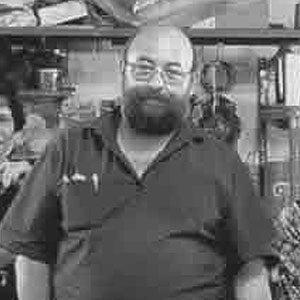| In Memoriam: José Ramírez IV Passed on June 5, 2000 |
|
| I met José Ramírez IV for the first time in the early 1980s. He was thirty-two at the time, a man of average height with broad shoulders, a full beard, and thick fingers. Our first dialogue was about the size of the Ramírez guitars; I complained about the difficulty of playing them. The bearded Spaniard insisted that they had to be exactly as they were and that reducing the string length would diminish the sound. I remember he described the hands of Yamashita, showing me how small they were, and offered that as proof that playing a Ramírez was only a question of proper technique. That was how our personal relationship started more than fifteen years ago. José Ramírez IV was born in 1953, the son of one of the greatest guitar makers of the 20th Century, José Ramírez III. His father had built guitars for practically every accomplished guitarist of his generation including Segovia, Parkening, and Bream. Ramírez IV grew up in a home where Segovia and his most respected students were both friends and clients of the family business. He knew that if he were to ever become a respected luthier, he would have to please the Maestro and those who followed him. In 1971 he went to work in the Ramírez workshop at the age of eighteen. At first he worked as an apprentice, but in 1977 he became the “oficial de 1a” — a title given to the most accomplished master craftsmen. In 1979, several guitars were brought to Andrés Segovia to choose the one he preferred. Unknown to Segovia, one of those instruments was made by the young José and it was that guitar which he selected. The young maker was so elated that he dedicated it to the Maestro and added this to the label. (The instrument was recently sold to a collector for $50,000.) Still, Ramírez IV believed that he had only succeeded in building the same instrument designed by his father and wondered how he could improve on it. Soon after he began to consider how to make the instrument easier to play while preserving the quality of sound and the overall volume. In 1986, he produced a smaller instrument (C-86) which had a smaller scale length but a smaller body as well. The sound was charming, but didn't have the same robust character as the original “1a” guitars. He still had some work to do. In 1988, José IV and his sister Amalia took over the business from their father. Amalia had also been trained in guitar building along with her brother. She, too, had made superb instruments under the direction of her father, but also had strong business skills which allowed José IV to concentrate on a revised construction of their concert model guitar. The same year at the Music Messe in Frankfurt I visited José IV and Amalia. Once again, we discussed the smaller Ramírez design and shared ideas about the relationship between volume of the instrument, size of the box, and string length. It was also during this Music Messe that I met Ana, their trusted translator, who later became my wife. “Pepe” and I had many differences of opinion over the years. In less than a few months time he offered me the exclusive distribution agreement in Taiwan and then angrily took it away when he discovered that my first guitar was going to pass through the USA on its way to the South China Sea. That was the other side of his absolute loyalty, both as a friend and in business. It was only after I became his exclusive distributor in the USA that I could fully appreciate this part of his character. During the early '90s, Pepe and Amalia were rethinking and rebuilding the business from the nearly one-thousand-guitars-a-year operation it had been under their father's direction to the one hundred-twenty-guitar-per-year workshop it is today. This was no easy feat in a country where it is nearly impossible to downsize a company due to the strong social democratic labor laws. Somehow they did it, kept the business going, and continued to improve on the quality control of the instruments. In 1993 they moved the business back to a smaller workshop with only a few journeymen supervised by both Pepe and Amalia. It is ironic that only now as the Ramírez distributor I am finally able to buy and sell the guitar I requested fifteen years earlier and it is especially ironic that it was Pepe who produced it. This was, in my view, his most important achievement in guitar making. In 1991, he redesigned the Ramírez 1a concert model and introduced the Traditional and the Especial model. These two models resembled those of 1960s in sound and construction while utilizing the standard 650MM scale length and a full-size body. With this, he achieved exactly what he thought to be impossible in our first meeting. José Ramírez IV died on Monday, June 5th, 2000, survived by his wife, sister, and four children. — Tim Miklaucic |
Top of Page |

